Family : Regulidae

Text © Dr. Gianfranco Colombo

English translation by Mario Beltramini
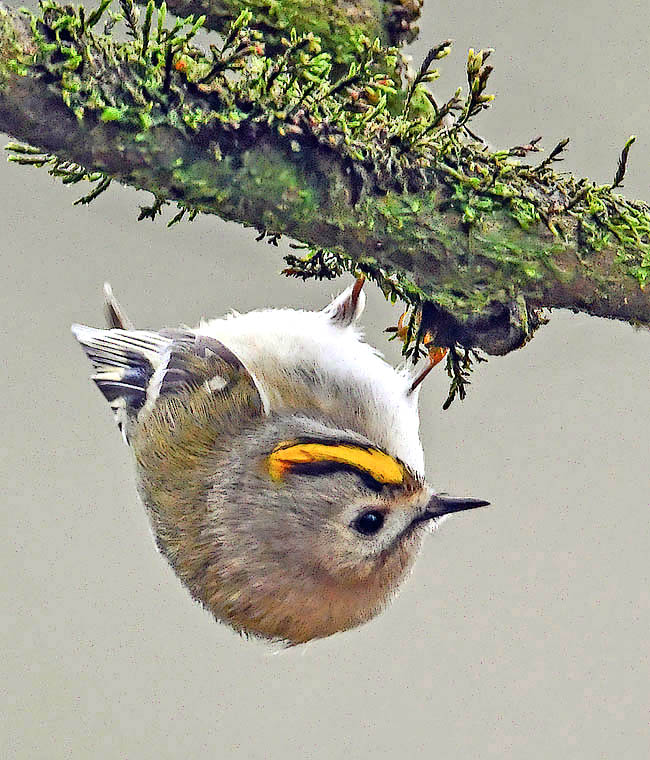
Weighing 5-7 g, Regulus regulus is the smallest Palearctic bird with the analogous congener Regulus ignicapilla © Frank Sengpiel
As small as this small bird is, its courage is great!
We could talk about a fight between a mouse and an elephant when we see it defending its nest or its female against predators or when it is fighting with other males for the conquest of its partner.
Nature, unluckily for it, has done it small and unarmed, without dangerous claws or terrifying beaks but does not affect the courage and the will it displays when it has these disputes.
If we then consider that the Goldcrest is the smallest European bird, appellation shared with its very similar congener Firecrest, we can well imagine what heroic instinct may lead this little bird.
The Goldcrest (Regulus regulus Linnaeus, 1758) belongs to the order of the Passeriformes and to the family of the Regulidae and is one of the six species belonging to this group.
The characteristic of the courage is not the only virtue, as this little bird with its delicate and defenseless appearance, manages to live and spend most part of the winter in environments with temperatures that many other birds, more robust and vigorous, avoid already in early autumn, even retreating beyond the Sahara desert, as they would not survive to such harsh climatic situations.
The result of this innate courage and recklessness towards any hostility, has however severe consequences on the life expectancy of this bird. In fact it is thought that the annual mortality reaches 80% of the population, thus reducing the average mathematical lifespan to less than 12 month: in fact, the longest-lived specimens would reach no more than 4 years.
Certainly these characteristics, added to the crown it has on the head, made it deserve a scientific name so regal to recognize it, in the noble title, the one it has not gotten in the size. As a matter of fact, the scientific name Regulus regulus is a tautonymous binomial repeating from the Latin, “rex, regis”, the name “regulus”, kinglet, petty king.
There is a legend about the origin of this nickname, which many consider dedicated to the Eurasian wren (Troglodytes troglodytes) but that, conversely, other deem consecrated to the Goldcrest.
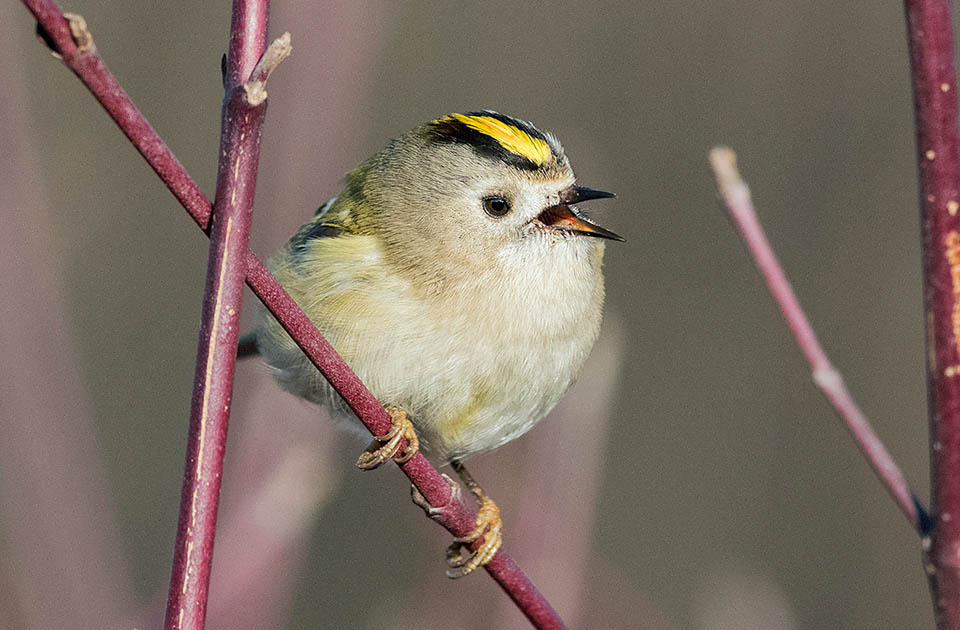
Graceful and rounded, practically without neck, has a very vast range covering discontinuously most Europe and central Asia up to Pacific © Gianfranco Colombo
It is said, at the time of Aesop and of Plutarch, that in a competition between birds to see who could fly the highest, the Goldcrest took flight to the sky first but was soon reached by the eagle on whose back it furtively clung hiding among the feathers and when very high, slipped out of its hiding place and overtook it at the finish line.
That is how it was that the Goldcrest was crowned king, proving that what was lacking in size it had in intelligence.
It is commonly called Goldcrest in English, Wintergoldhähnchen in German, Reyezuelo Sencillo in Spanish, Roitelet huppé in French, Estrelinha de poupa in Portuguese, Regolo in Italian and Kikuitadaki in Japanese.
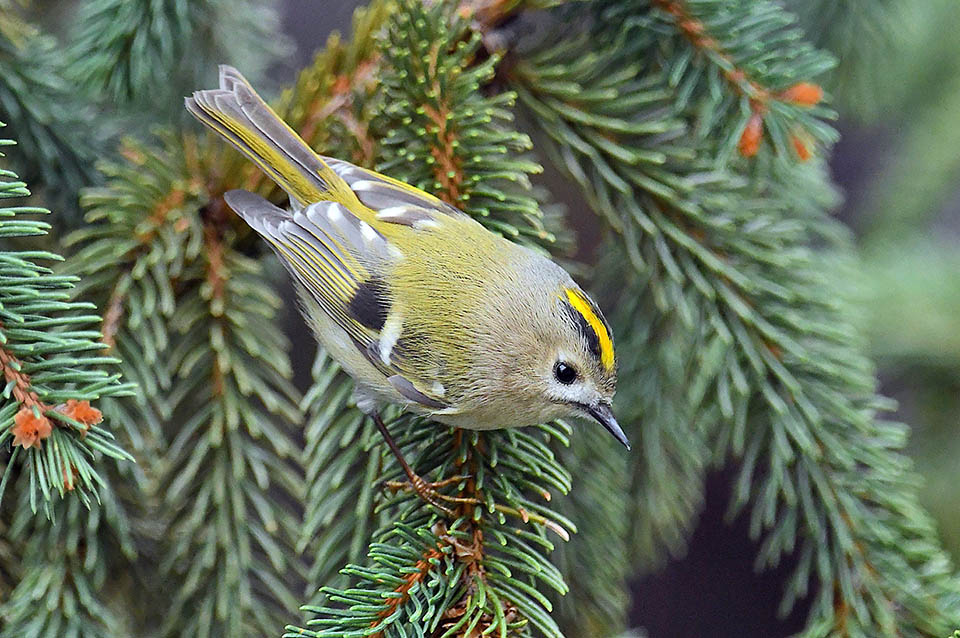
Loves conifer forests and its life occurs in practice between the high branches of the trees and rarely gets down, even less to touch the ground © Vasily Kalinichenko
Zoogeography
The Goldcrest has a very large range including most of Europe and, through a wide belt going, limited south by the cool temperate area of central Asia and north by the western Siberian tundras, in a discontinuous manner up to the Pacific Ocean coast.
More specifically, in Europe it occupies all the central northern part up to the Arctic Ocean coasts, avoiding the Mediterranean area, indicatively below the 45° parallel, with the exception of the mountainous areas of the Iberian Peninsula, the Pyrenees, isolated territories of the Apennines, and along the Balkan ridge up to Greece. In Anatolia, it is present only on the mountain areas overlooking the coasts of the Mediterranean as well as those of the Black Sea, to then continue on the Caucasus until reaching the Caspian Seas shores.
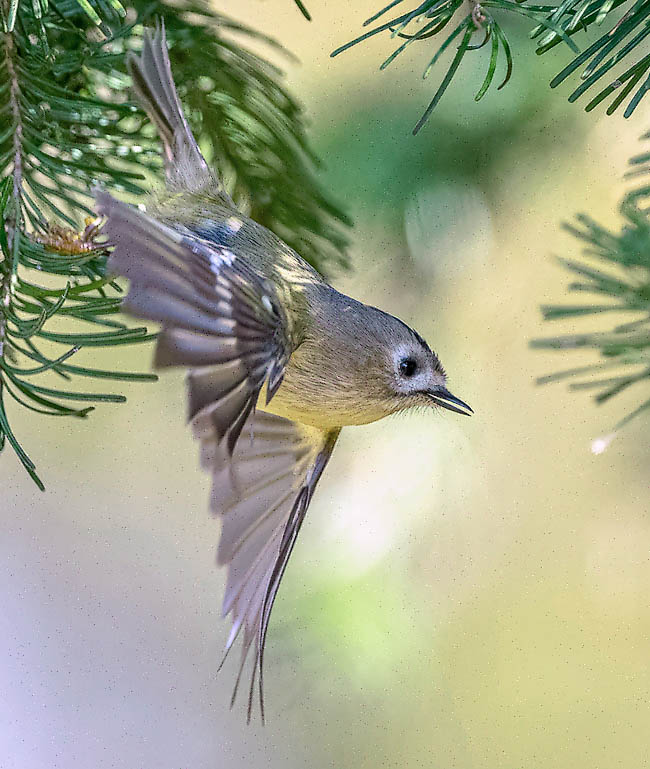
Pines, firs and larches, but also mixed woods of birches. Reaches with strong adaptation the mountain slopes at the limit of the tree vegetation and during winter accepts also the cultivated fields and the gardens © Dmitry Dubikovskiy
In central Asia it occupies all mountain ranges and the overlooking valleys, over the 50° parallel, up to the Mongolian Altai, where it suddenly ceases its presence to start again in Manchuria and ends in Japan,Korean Peninsula and Sakhalin. It is present also in Macaronesia with endemic subspecies.
The Goldcrest is a migratory bird who abandons, during the winter, the coldest ranges of its territory to reach more southern environments, even if these often have weather conditions that have nothing to do with a wintering site. In some winters, only the extreme part of the northern range is abandoned, holding the positions in the other nesting areas but only descending to a lower altitude in order to avoid the rigors of the high mountain.
In winter it is widely present in the Mediterranean area and in Asia, in the slightly more southern strip of the range of the area inhabited while nesting.
Ecology-Habitat
The Goldcrest is a typical inhabitant of coniferous forests and of vast pine forests with or without undergrowth, as its life takes place only among the high branches of the trees and almost rarely descends down, even less to touch the soil.
It has a preference for pine and fir trees but also larches, as well as for mixed bich forests and, on the mountain slopes at the limit of the tree line, the mountain pines.
The Goldcrest loves temperatures and environments cooler than its congener Firecrest (Regulus ignicapilla) even if in the southern quarters the species share the same areas.
However, during the winter period, it has a strong spirit of adaptation and accepts environments totally different from those usually inhabited while nesting, that range from the Mediterranean scrub to the cultivated countrysides intersected by rows of trees and of lowland groves, wooded banks invaded by brambles and also planted city gardens with exotic tree species.
During this period it often gathers in numerous flocks that regroup Blue tits and Long-tailed tits, Treecreepers and Great tits, Firecrests and small Warblers and, together, sift every branch or bush, barks and holes, looking for the last remaining insects.
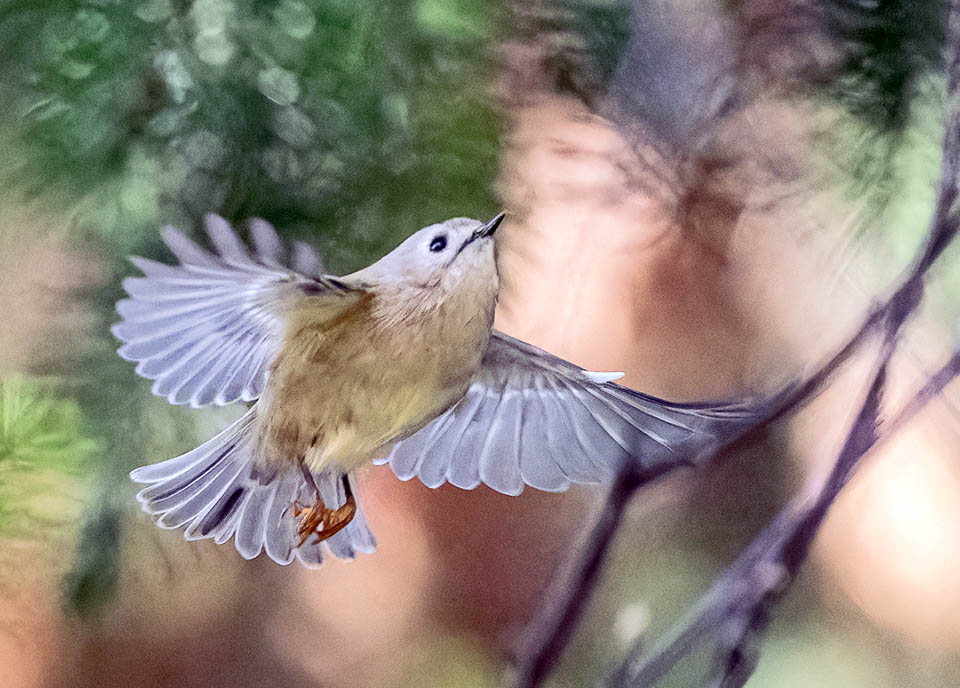
The not exceeding 15 cm wingspan allows it to sneak in nimbly into any vegetation © Dmitry Dubikovskiy
Morphophysiology
The Goldcrest is distinguishable from all other birds because it carries on the head a bright yellow orange tuft of feathers, accompanied by two black lines crossing the head stopping in the occipital area, characteristic it maintains constant throughout the year.
In addition to this it is to be considered that it is the smallest bird present in the Palearctic together with the congener Firecrest and therefore the possible confusion in the determination is even easier by the particular dimensions.
Moreover the Firecrest, who is quite similar to the Goldcrest in the shape as well as in the behaviour, distinguishes from this as having a well defined and always visible white eyebrow, absent in the Goldcrest.
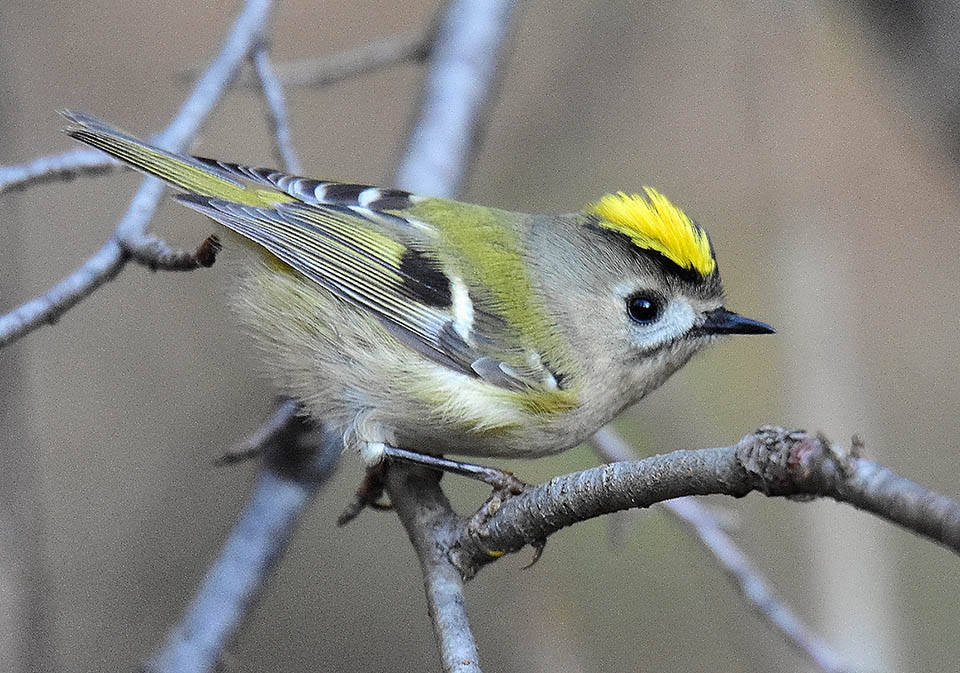
The Goldcrest sexual dimorphism limits to the colour of the tuft. In the females this is mainly yellow © Илья Сухов
The plumage of the back has a beautiful olive green colour covering also the rump up to the tail whilst the chest and the belly are whollu of a pale greenish pale colour. The wings carry two alar bars, one white and one very black, and they too are always clearly visible. The tail is notably forked at the end and always moving, seen that it is used as balancer during the movements it does among the branches while looking for food.
Legs and bill are very black besides the eyes, particularly round and that are rather big if compared to the size of the little bird. There is a very limited sexual dimorphism in the livery of the Goldcrest, not always visible on the field and that displays in the males a greater extension of the yellow tuft and a slightly brighter colour.
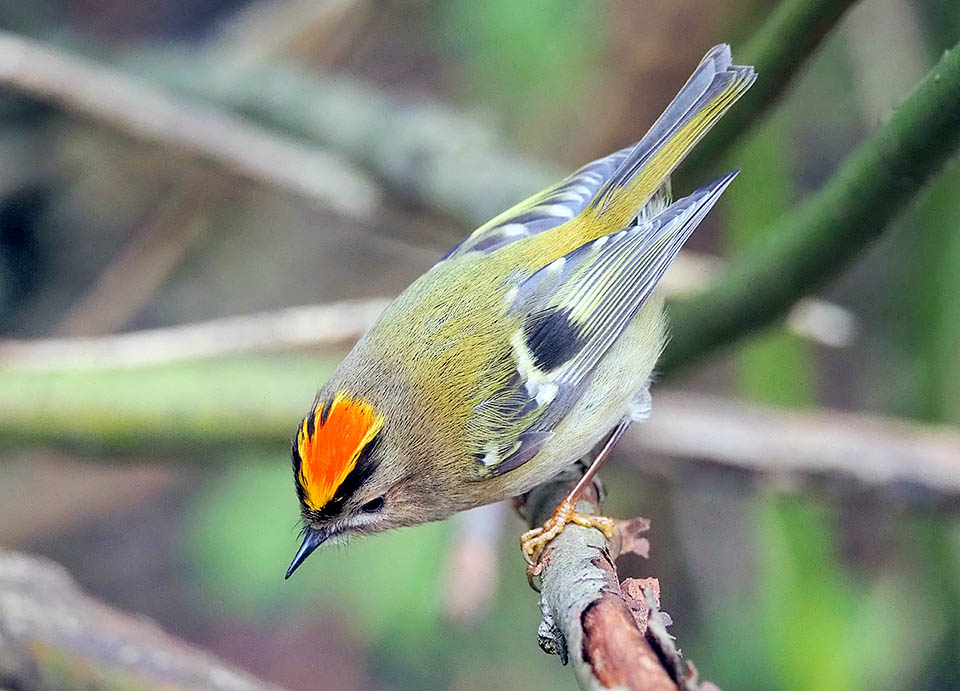
Conversely orange is bright in the males, emphasized by the yellow border preceding the black bands © vm_ovchinnikov
The dimensions of the Goldcrest are extremely reduced: in fact it measures about 9 cm in length, a wingspan not exceeding 15 cm and a weight going from 5 to 7 g, practically the weight of a coin!
Given the large area inhabited by this little bird, the classification of a good number of subspecies has been natural.
In Europe up to Siberia we have the Regulus regulus regulus.
In Macaronesia stand many enedemisms typical of the various islands: Regulus regulus ellenthalerae, Regulus regulus teneriffae, Regulus regulus azoricus, Regulus regulus inermis and Regulus regulus sanctaemariae. In Anatolia and up to Iran, the Regulus regulus buturlini and Regulus regulus hyrcanus.
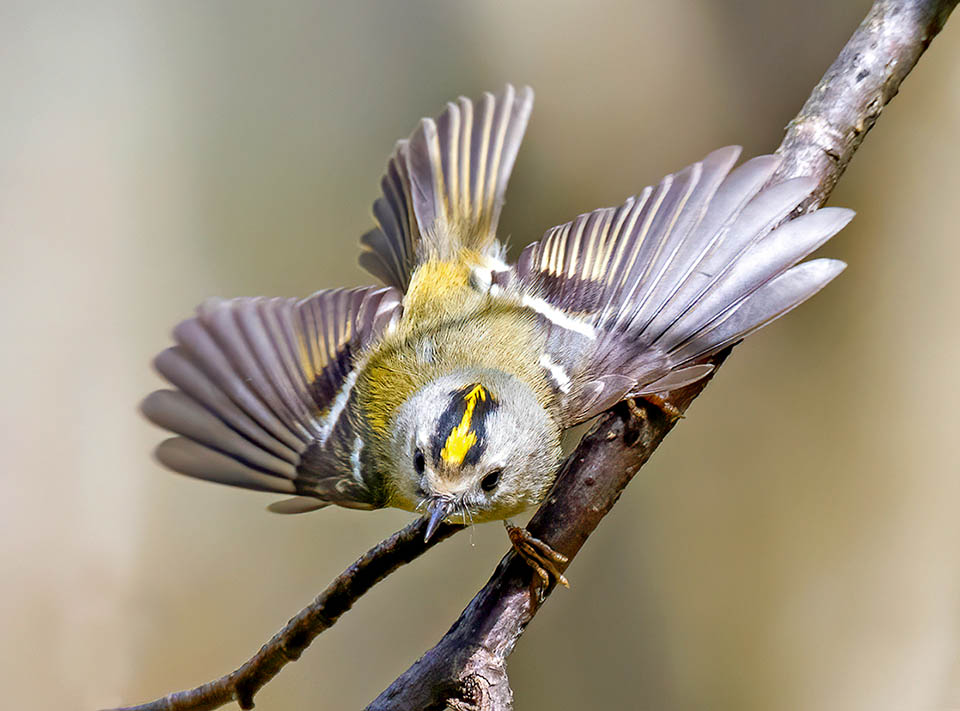
Despite its size, Regulus regulus is an aggressive bird who defends tenaciously its territory, especially like this female during the nesting period © Mikhail Ezdakov
In the Himalayan area, the Regulus regulus coatsi, Regulus regulus tristis and Regulus regulus himalayensis; in central Asia, the Regulus regulus sikkimensis and Regulus regulus yunnanensis and in the extreme part of East Asia, the Regulus regulus japonensis.
Ethology-Reproductive Biology
The nest of the Goldcrest is a real work of art and it is so well done and camouflaged that it is very difficult to find it. Moreover, it loves to place it on the higher branches of the conifers, therefore besides the reduced size, we have to add the impossibility to observe it closely. During nesting the Goldcrest is a solitary subject and the life in a couple is carried on in a territory separated and highly defended against any other conspecific.
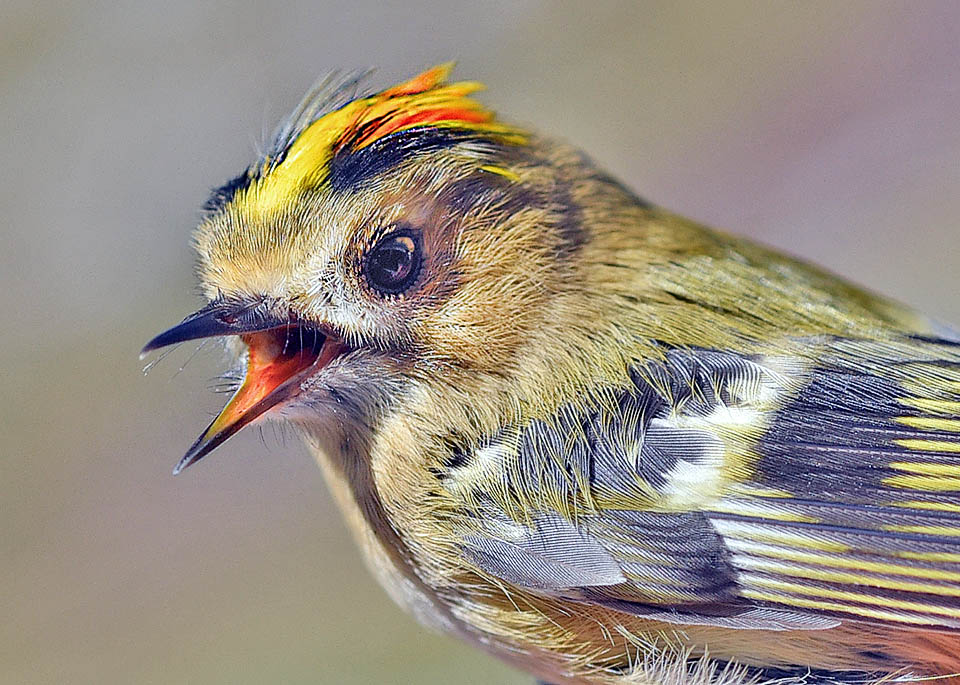
When excited or incited, often ruffles its plumage to display the aggressiveness emitting shrill sounds © Gianfranco Colombo
Every invasion of the field is harshly opposed until the intruder is driven away.
This fact can be easily observed during the ornithological censuses when, with a simple sound prompt from one of their pre-recorded songs, we can see coming after a few seconds, just a very few metres far, the excited and aggressive couple and from their behaviour it’s a good thing that it is not the size of a large bird of prey!
The nest is a perfect and deep cup, built almost totally by the female, weaving cobwebs, mosses and lichens, on the extreme tip of the branches dangling among the hanging needles of the conifers, at a height sometimes exceeding even 20 m though by often exploiting the lowest branches.
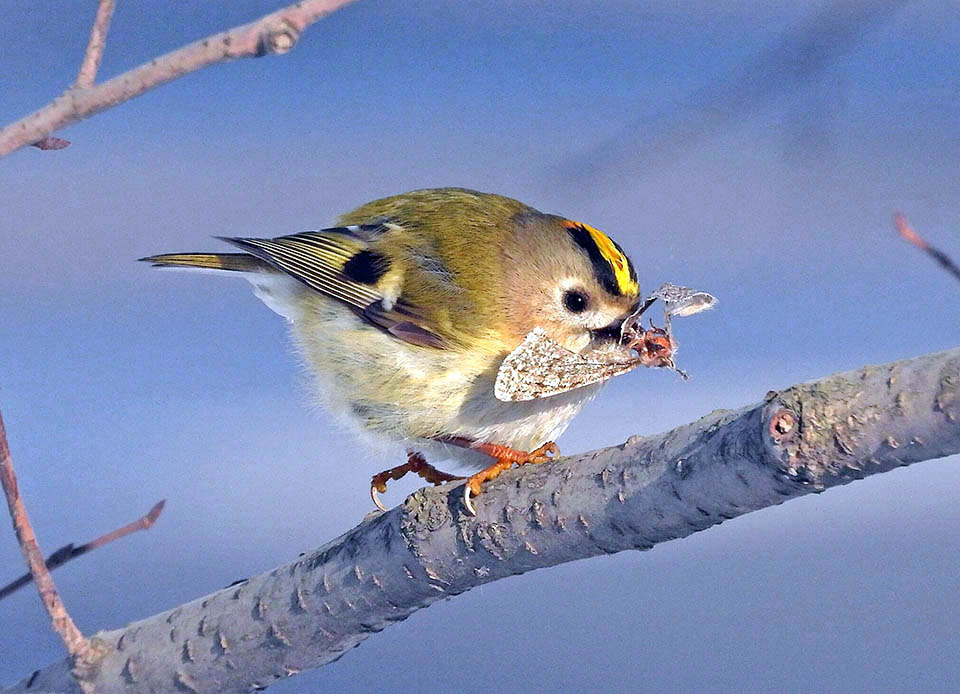
Usually Goldcrest feeds on insects, including the lepidoptera with their larvae and pupae © allagrigoreva175
The interior is lined with animal hair and soft down.
As already mentioned, the mortality rate of these little birds is very high, consequently nature has endowed them with a remarkable prolificacy, managing to lay a very high number of eggs that sometimes reaches a dozen. On average the brood is six, seven white eggs, with a very light brownish stippling that are incubated by the female.
Often the eggs do not have enough room for laying on the bottom of the small nest for which they get overlapped in layers complicating the hatching operations. In that case the female often stands slightly raised on its legs, in order to distribute the heat to all the eggs.
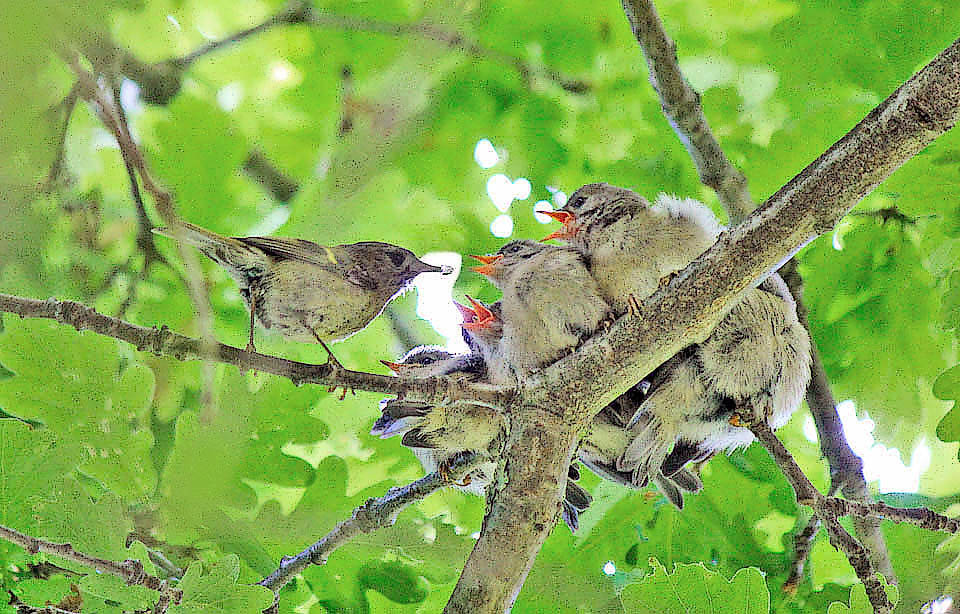
Broods are usually large and numerous to compensate the high young mortality rate typical of the species © elliehawcutt
The assiduity shown in hatching is remarkable, as the nest is left only for very few minutes, just the time for feeding itself and running back to the family duties.
Hatching lasts about 20 days and the nestlings will remain for 3 weeks more before flying off.
Two broods are laid annually.
The Goldcrest is a purely insectivorous bird and eats caterpillars and chrysalises, small insects, their eggs and larvae, spiders and aphids. Only rarely, perhaps imitating other similars with whom spends the winter, pecks at some ripe fruit and sweet berries.
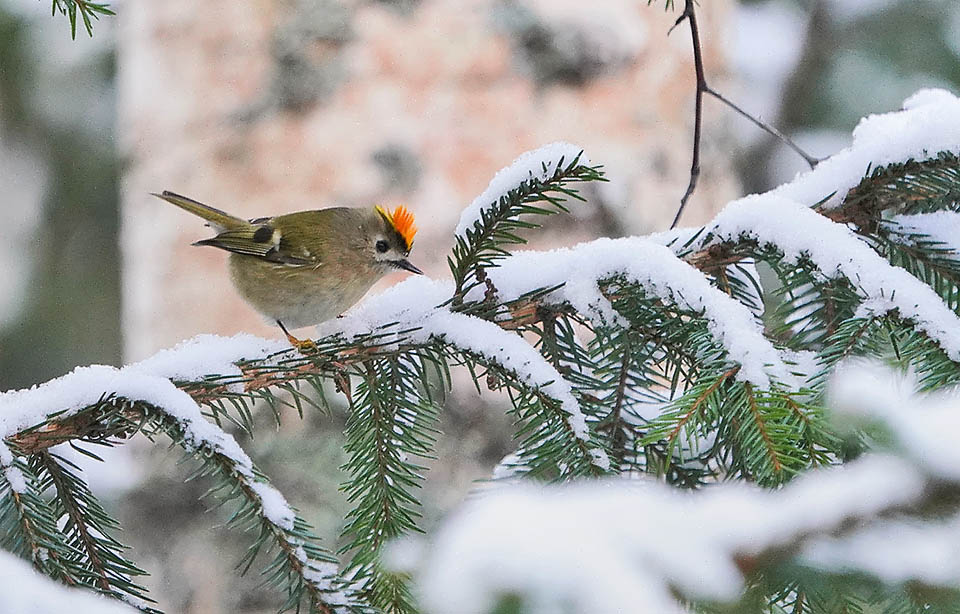
The Goldcrest easily tolerates very rigid climates but with the cold arrival prefers to go down the valley also hibernating in the Mediterranean area © elliehawcutt
The Goldcrest, like all small insectivorous birds, has an incredibly fast metabolism that obliges it to eat continuously in order to get the energy sufficient for surviving.
It is thought that more than 90% of its day time is spent looking for food, without which it would meet a dangerous debilitation, so much to compromise its very life.
Like the swifts also the Goldcrest may self-regulate its body temperature to very low levels, succeeding for short periods to reach a state of slight numbness that allows it to overcome periods of reduced nutrition.
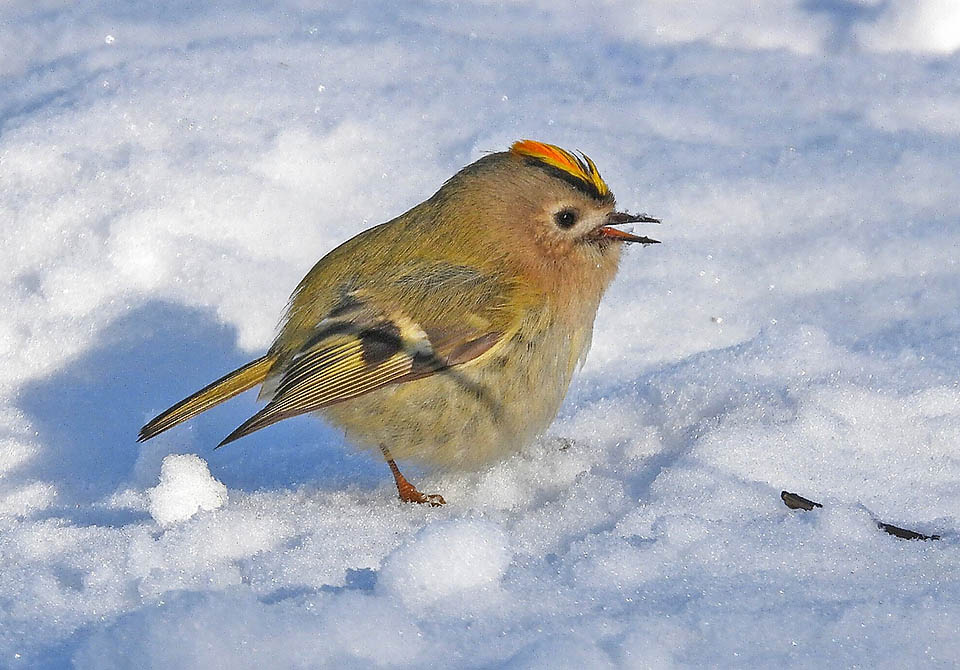
Here it is casually on the ground in a little-frequented site to peck insects fallen due to snowfall or severe frost © allagrigoreva175
However it is not always the definitive solution: a condition that the juveniles at their first winter are often unable to deal with and is the cause of that decimation that affects this small and cute bird that however appears as “LC, Least Concern“, in the IUCN Red List of the endangered species.
The song of the Goldcrest has an ultrasound tone and is often inaudible to humans. The particular tzi tzi tzi is used as ong connecting with the similars and is emitted continuously during the winter raids, whilst in full nesting season it keeps almost silent.
Synonyms
Motacilla regulus Linnaeus, 1758.
→ To appreciate the biodiversity within PASSERIFORMES please click here.
